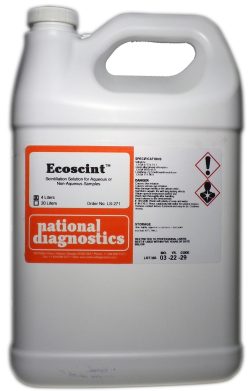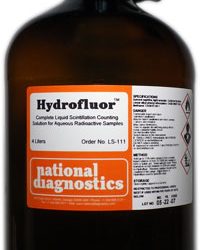Liquid Scintillation
Ecoscint ORIGINAL
$182.00 – $746.00
Catalog Number: LS-271
- The Original Ecologically Responsible Scintillation Fluid
- Readily Biodegradable
- Economical
- Robust Sample Handling
- Excellent All-Around Performance
Description
Catalog Number: LS-271
- The Original Ecologically Responsible Scintillation Fluid
- Readily Biodegradable
- Economical
- Robust Sample Handling
- Excellent All-Around Performance
Ecoscint is the first ecologically friendly scintillation solution. Ecoscint offers the convenience of a complete and ready-to-use solution for both aqueous and non-aqueous samples. Substantially less toxic than conventional scintillation fluids, Ecoscint is biodegradable and non-flammable.
Ecoscint has comparable efficiency and greater sample holding capacity than conventional scintillators and maintains a single liquid phase up to saturation.
Additional information
| Weight | 45 lbs |
|---|---|
| Dimensions | 15 × 10 × 13 in |
Safety Overview
Safety Summary (see SDS for complete information before using product):
Appearance and odor:
Clear liquid with blue phosphoresence and mlld odor
Harmful by inhalation, in contact with skin and if swallowed may cause sensitization by inhalation.
In case of contact with eyes, rinse immediately with plenty of water, and seek medical advice. Wear suitable protective clothing.
EMERGENCY OVERVIEW – IMMEDIATE HAZARD
Nalkylene
MAY BE IRRITATING TO THE SKIN, EYES, AND RESPIRATORY TRACT.
Linear alkyl phenyl ethoxylates
CAUSES EYE IRRITATION. MAY CAUSE RESPIRATORY TRACT IRRITATION.
- Waste Disposal Issues in Scintillation Counting
- The Complete Scintillation Cocktail
- Radioactive Emissions and the Use of Isotopes in Research
- Preparing Tissue Samples for Scintillation Counting
- Preparing Samples in PAGE Gels for LSC
- Mechanism of Liquid Scintillation Counting
- Measurement of Radiation and Isotope Quantitation
- Liquid Scintillation Signal Interpretation
- Liquid Scintillation and Radiation Safety
- HPLC Flow Counting
- Counting Samples on Cellulose-Ester Filters
- Counting Samples from TLC Plates by LSC
- Counting Efficiency and Quenching
- Counting Carbon Dioxide by LSC
- Chemiluminescence and Static Electricity
- Assaying Discrete Samples by Liquid Scintillation Counting



